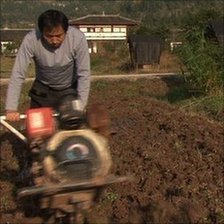Markets for agricultural products is another critical component of the value chain – i.e from the time the produce is ready for harvest till it reaches the final consumer. A number of activities take place within this period from storage, processing, transportation, retail, and wholesale that add value to the produce. These value adding processes are greatly affected by factors such as inefficiencies in trade policies – both local and international, poor post-harvest handling techniques, challenges with storage and processing, limited infrastructure for transportation of produce, and lack of access to credit by farmers at the lean season to help them extend shelf life of their produce.
In the context of communication, the World Bank’s eSourcebook defined marketing in terms of “finding out” what customers want and “supplying it” to them. ICT solutions that target markets for farmers’ produce may have features that connect producers to traders, provide market alerts and status of prices to both producers and traders at various markets, facilitate easy and smooth transactions and price negotiations, ensure easy flow of goods across regions/states, aid market research, and improve storage and processing challenges for value chain actors. Effective deployment of these tools will increase food availability, increase income of producers and traders, minimize post-harvest losses, and help stabilize food prices.
Potential applications of ICTs for retail activities
Smallholder farmers are producers and at the same time retailers. Commodities produced beyond household consumption go to the market for retail. Farmers sell at the farm gate, in their homes, local markets and regional markets to get cash to meet other social and economic needs at home. But due to poor market information at the time of harvest (even at the time of cultivation), farmers are exploited by middlemen or market women who determine the price, and most of the times, the farm produce are left to rot at the farm or the market due to glut in market at the time of harvest. ICTs are helping to reduce this challenge in most developing countries to increase market information for producers. These ICT solutions may support activities of smallholder farmers, traders and consumers with market information and other transaction processes to help deliver produce to the consumers.
Examples include the use of Agriculture Price Alert, an iPhone mobile application that send push notification to users (farmers, traders, consumers) when prices reach the limit they set; M-Farm, a mobile application that helps users to get up to date crop price information, connect farmers together to jointly sell their produce, and help group-buying of farm utilities together; and CellBazaar that uses a suite of applications including SMS, the web and voice to bring ‘the market’ to the handset of its users.
Potential applications of ICTs for wholesale activities
Farm produce also travels from the farm gate to wholesale markets and supermarkets. The produce undergoes value-adding processes such as sorting, storage, processing, grading, packaging, labeling and certification, which may be undertaken by the farmer or the wholesaler. The entire process involves logistics and communication to be able to deliver the right product to the right market. There are specific ICT solutions that support activities of commercial farmers, traders, processors, graders and consumers with market information and transaction processes to ensure quality products in the market. Some of these activities cut across national and regional boundaries for international markets.
Examples include Virtual City AgriManagr, which allows traders to manage the weighing, grading and receipting of their produce collected from each farmer at the collection point and pay suppliers using cashless transactions, Regional Agriculture Trade Intelligence Network (RATIN) which supplies traders with improved early warning marketing and trade information leading to more efficient and competitive transactions in food trade between surplus and deficit regions in East Africa, and the Africa Commodities and Futures Exchange (ACFEX), a Pan-African multi-asset derivatives exchange that provides a continent wide price discovery mechanism, transparency, risk management in a number of areas including agriculture.
In conclusion, a range of ICT solutions are within this “marketing” category of the value chain. Solutions providing market information to farmers prior to cultivation for decision on what crop to cultivate and how much to farm; those that give price alerts from different market locations for farmers to decide on who to sell their produce to; others that connect farmers and traders together to negotiate and exchange their commodities; those that facilitate transactions and payments; and other solutions that ensure storage/warehousing to help add value to the produce and increase farmers’ income.












































